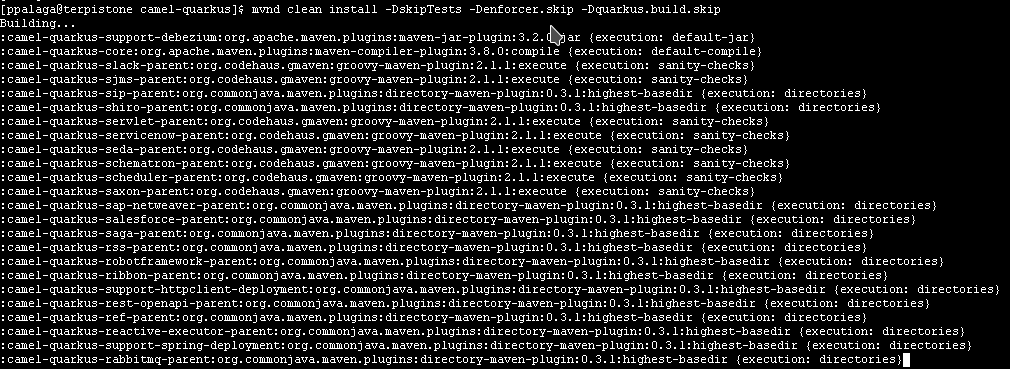This project aims at providing faster Maven builds using techniques known from Gradle and Takari.
Architecture overview:
-
mvndembeds Maven (so there is no need to install Maven separately). -
The actual builds happen inside a long living background process, a.k.a. daemon.
-
One daemon instance can serve multiple consecutive requests from the
mvndclient. -
The
mvndclient is a native executable built using GraalVM. It starts faster and uses less memory compared to starting a traditional JVM. -
Multiple daemons can be spawned in parallel if there is no idle daemon to serve a build request.
This architecture brings the following advantages:
-
The JVM for running the actual builds does not need to get started anew for each build.
-
The classloaders holding classes of Maven plugins are cached over multiple builds. The plugin jars are thus read and parsed just once. SNAPSHOT versions of Maven plugins are not cached.
-
The native code produced by the Just-In-Time (JIT) compiler inside the JVM is kept too. Compared to stock Maven, less time is spent by the JIT compilation. During the repeated builds the JIT-optimized code is available immediately. This applies not only to the code coming from Maven plugins and Maven Core, but also to all code coming from the JDK itself.
mvnd brings the following features on top of the stock Maven:
-
-T1Cis used by default. This means builing in parallel using as many threads as CPU cores on your machine. If your source tree does not support parallel builds, pass-T1on the command line to make your build serial. -
Improved console output: we believe that the output of a parallel build on a stock Maven is hard to follow. Therefore, we implemented a simplified a non-rolling view showing the status of each build thread on a separate line. This is what it looks like on a machine with 24 cores:
Once the build is finshed, the complete Maven output is forwarded to the console.
Install using SDKMAN!
If SDKMAN! supports your operating system, it is as easy as
$ sdk install mvndIf you used the manual install in the past, please make sure that the settings in ~/.m2/mvnd.properties still make
sense. With SDKMAN!, the ~/.m2/mvnd.properties file is typically not needed at all, because both JAVA_HOME and
MVND_HOME are managed by SDKMAN!.
-
Download the latest ZIP suitable for your platform from https://github.com/mvndaemon/mvnd/releases
-
Unzip to a directory of your choice
-
Add the
bindirectory toPATH -
Optionally, you can create
~/.m2/mvnd.propertiesand set thejava.homeproperty in case you do not want to bother with settingJAVA_HOMEenvironment variable. -
Test whether
mvndworks:$ mvnd --version Maven Daemon 0.0.0 (native) Apache Maven 3.6.3 (cecedd343002696d0abb50b32b541b8a6ba2883f) Maven home: /home/ppalaga/orgs/mvnd/mvnd/daemon/target/maven-distro Java version: 11.0.1, vendor: AdoptOpenJDK, runtime: /home/data/jvm/adopt-openjdk/jdk-11.0.1+13 Default locale: en_IE, platform encoding: UTF-8 OS name: "linux", version: "5.6.13-200.fc31.x86_64", arch: "amd64", family: "unix"
If you are on Windows and see a message that
VCRUNTIME140.dll was not found, you need to installvc_redist.x64.exefrom https://support.microsoft.com/en-us/help/2977003/the-latest-supported-visual-c-downloads. See oracle/graal#1762 for more information.
mvnd is designed to accept the same command line options like stock mvn (plus some extras - see below), e.g.:
mvnd clean install-
git -
Maven
-
Download and unpack GraalVM CE from GitHub
-
Set
JAVA_HOMEto where you unpacked GraalVM in the previous step. Check thatjava -versionoutput is as expected:$ $JAVA_HOME/bin/java -version openjdk version "11.0.7" 2020-04-14 OpenJDK Runtime Environment GraalVM CE 20.1.0 (build 11.0.7+10-jvmci-20.1-b02) OpenJDK 64-Bit Server VM GraalVM CE 20.1.0 (build 11.0.7+10-jvmci-20.1-b02, mixed mode, sharing)
-
Install the
native-imagetool:$ $JAVA_HOME/bin/gu install native-image -
native-imagemay require additional software to be installed depending on your platform - see thenative-imagedocumentation.
$ git clone https://github.com/mvndaemon/mvnd.git
$ cd mvnd
$ mvn clean verify -Pnative
...
$ cd client
$ file target/mvnd
target/mvnd: ELF 64-bit LSB executable, x86-64, version 1 (SYSV), dynamically linked, interpreter /lib64/ld-linux-x86-64.so.2, BuildID[sha1]=93a554f3807550a13c986d2af9a311ef299bdc5a, for GNU/Linux 3.2.0, with debug_info, not stripped
$ ls -lh target/mvnd
-rwxrwxr-x. 1 ppalaga ppalaga 25M Jun 2 13:23 target/mvndThis project is still in prototype mode, so feedback is most welcomed!
